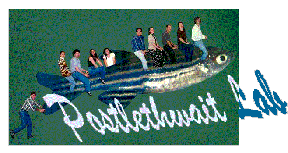Lab
Postlethwait Zebrafish Genetics Laboratory
|

|
Statement of Research Interest
Gene duplication is a common event, and principles that govern the evolution of duplicated genes impact the molecular genetic mechanisms of morphogenesis. An understanding of how duplicated genes evolve is especially important among fish because whole genome duplication has been a recurring theme in ray-fin fish phylogeny. To investigate genome structure in a teleost fish, we have placed over 1524 genes and ESTs and over 610 SSLPs (simple sequence length polymorphisms) on a zebrafish doubled haploid meiotic mapping panel (the Heat Shock Panel). Our mapping has revealed the following general principles: (1) The zebrafish genome shares large regions of conserved synteny with mammalian genomes, sometimes about as long as individual mammalian chromosomes. For example, results suggest that most of the loci on human chromosome 17 have remained syntenic since the divergence of ray-fin and lobe fin fish 450 million years ago. (2) Within conserved regions, intrachromosomal rearrangements have frequently altered gene order; thus, inversions have been much more common than chromosomal translocations. (3) Zebrafish chromosomes are mosaics of mammalian chromosomes. (4) Zebrafish frequently has two orthologues of many mammalian genes (about 30%), and these map in duplicated chromosome segments. This result suggests an ancient whole genome duplication event in the zebrafish lineage. When did this genome duplication occur in ray-fin fish phylogeny? Data remain scanty, but are consistent with the hypothesis that an ancient tetraploidization event occurred before the teleost radiation, and so is in the genomic heritage of all teleosts.
After gene duplication, usually one gene copy becomes mutationally silenced and disappear over time (nonfunctionalization). Alternatively, both duplicate copies may be preserved if either(1) beneficial mutations occur in one or both copies that allow the evolution of new functions (neofunctionalization), or if (2) degenerative mutations result in the partitioning of the tasks of the ancestral gene subfunctionalization). Thus, gene duplicates in teleost fish may sum together to perform the functions of their single copy mammalian orthologue. Furthermore, if duplicate gene subfunctions remained unresolved at the time that different teleost lineages diverged, then truly orthologous genes in different fish species may have different functions in development. And if both duplicate genes were completely intact at the time of lineage divergence, then independent nonfunctionalization of different copies in different lineages could lead to different gene contents in orthologous chromosome segments of different teleosts. If the hypothesis of a shared genome duplication is substantiated for teleost fish, then the comparative biology of the molecular genetic mechanisms of morphogenesis must address these principles that appear to govern the evolution of duplicate genes.
After gene duplication, usually one gene copy becomes mutationally silenced and disappear over time (nonfunctionalization). Alternatively, both duplicate copies may be preserved if either(1) beneficial mutations occur in one or both copies that allow the evolution of new functions (neofunctionalization), or if (2) degenerative mutations result in the partitioning of the tasks of the ancestral gene subfunctionalization). Thus, gene duplicates in teleost fish may sum together to perform the functions of their single copy mammalian orthologue. Furthermore, if duplicate gene subfunctions remained unresolved at the time that different teleost lineages diverged, then truly orthologous genes in different fish species may have different functions in development. And if both duplicate genes were completely intact at the time of lineage divergence, then independent nonfunctionalization of different copies in different lineages could lead to different gene contents in orthologous chromosome segments of different teleosts. If the hypothesis of a shared genome duplication is substantiated for teleost fish, then the comparative biology of the molecular genetic mechanisms of morphogenesis must address these principles that appear to govern the evolution of duplicate genes.
Lab Members
| Amores, Angel Post-Doc | Bassham, Susie Post-Doc | Cañestro-García, Cristian Post-Doc |
| Cresko, William Post-Doc | Yan, Yi-Lin Post-Doc | BreMiller, Ruth Research Staff |
| Cortes, Vincent Research Staff | Currey, Mark Research Staff | Desvignes, Thomas Research Staff |
| Murphy, Joy Research Staff | Starks, Amber M. Research Staff | Titus, Tom A. Research Staff |
| Wilson, Catherine Research Staff | He, Xinjun |
